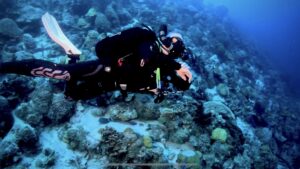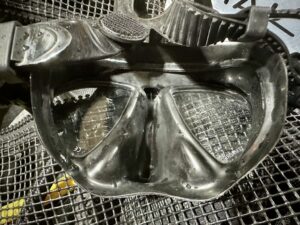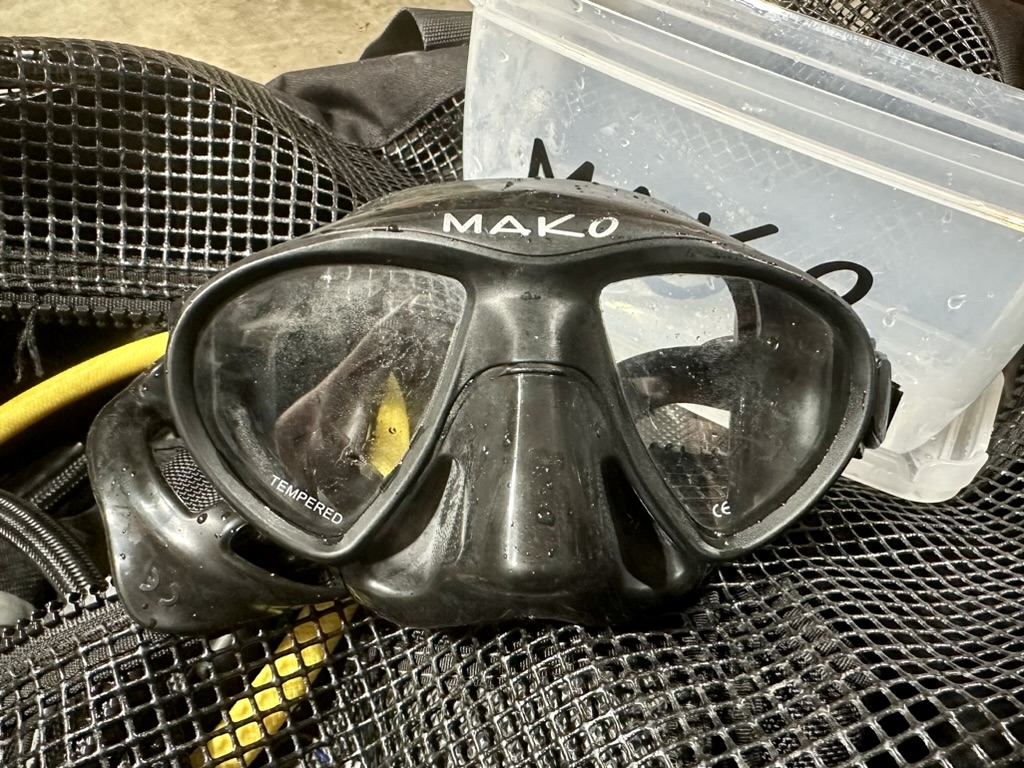Mako Minimus Mask Review: Can the Minimus Stack Up to the Aqualung Micromask?
I have been using the same mask for about 15 years. It’s the Aqualung/Techni-Sub Micromask, and like thousands of other Micromask loyalists, I have a few. For technical dives, I always carry 2 masks, so having one more in my bag ensures I won’t find myself stuck without a backup.
I love this mask. It fits my face and is exceptionally low volume with a wide field of view.
Recently, I learned two things: One is that Aqualung stopped making the Micromask some months ago, and has replaced it with some “new” version. Second, if you need a Micromask replacement strap, you’re basically SOL. I found a ScubaPro strap that’s close, but the mask doesn’t feel, or seal the same as it did with the original.
The search for a Micromask replacement
I’ve been casually looking for a similar mask for a few years. Seac has a one, as do Omer (ugliest mask I have ever seen) and several other brands. I’m a gear hound. Partly it’s just part of being a technical diver and instructor, along with all the types of diving I do. But also, I just love dive gear, and there’s always something new to buy that promises to make my underwater experiences better.
But, I’ve just never found another mask that measures up to the Micromask. It has always just fit.
The “new” version doesn’t even come in black. On top of that, it is a completely different dive mask. My suspicion is they did away with “Made in Italy” in favor of “Made in China,” to cut costs. I understand the motivation, but I don’t like it.
I also looked at that new Aqualung “tech” mask with the stainless steel screws. I’d like to try it, but it’s not the same thing at all.
Choosing the right dive gear is a challenge—especially a mask
I am extremely selective about dive gear. Very often, little things make a huge impact on comfort and trim. I haven’t thought too much about my mask, since the Micromask has always been near-perfect.
In my opinion, the dive store method of choosing a mask by sucking it onto your face without the strap is inadequate. I can’t count all the divers I’ve seen put up with leaky masks that fit “perfectly” in the dive shop.
To really test a dive mask for fit, you have to take it diving. We don’t swim around, all the while sucking in through our noses. Anyway…
On to the Mako Minimus
I first learned of the Mako Minimus at the most recent (2023) DEMA Show in New Orleans. It looks a lot like the Micromask, so I took pictures with my phone, but didn’t handle it or talk to anyone at the Mako booth. At the time, I didn’t even know what it was called, but knew I wanted to do some research later.
Several weeks later, the above mentioned strap broke on one of my Micromasks, so I went back through the pictures to remember what I saw at DEMA.
I’d call the Minimus a copy of the Micromask, except that the strap is attached directly to the skirt rather than the frame. That’s a big difference, although not obvious until you handle them both.
Buying online, price, etc.
Mako is a direct to consumer brand. Keep in mind, I am 100% in favor of supporting local dive shops. In fact, I avoid buying dive gear online if I can get what I want or need locally. There is no substitute for being able to walk into a shop and get advice, parts, training, gas and all the other things that make it possible to keep diving.
That said, there is only place to buy a Mako mask—the Mako website. Here’s a link: https://makospearguns.com/minimus-aka-mini-freedive-mask/. By the way, I don’t get anything if you buy one. There’s no affiliate commission and Mako has no idea I am writing about their Minimus Mask.
The Mako Minimus Mask is $35

You can’t beat the price. Before ordering, I found a few forum discussions about it. Over all, divers seemed to like the Minimus. A few suggested the build quality isn’t as good as the Aqualung Micromask. There was also some mention of the attachment point being the skirt, rather than the frame.
Questions about durability seemed more speculative than anything, since nothing that I read mentioned diver’s Minimum masks actually breaking.
My impression is that the buckles are not the same mold quality as Aqualung. However, they work more or less the same. Squeeze to loosen—pull to tighten…
As for being attached at the skirt, maybe it’s less durable, maybe not. I do believe attaching the strap closer to your face very likely puts strap tension in a better position than out on the corners of the frame.
Mako Minimus in the water…
I received my new mask the day before I would be teaching an Open Water course in the pool. This was perfect because I’d have my usual mask handy if things didn’t work out. If I liked the Minimus, I’d be wearing it for 4-5 hours. It’s one thing to have a good seal and to be comfortable during typical hour-long dives. Rebreather dives can be 3 hours or more. Minor fit issues become major fit issues during extended dives, so I felt the pool session would be an ideal test.

At first, it felt different than I’m used to. I think the skirt is slightly more rigid. However, because of the strap mounting point, I feel like I can wear it looser and still achieve a perfect seal.
After a bit of fiddling, I had the mask adjusted and mostly forgot about it until I had to demo mask clearing for my students. I told them this would be the first time clearing my new mask and used the occasion to explain that every mask and face combination is different.
Whenever I test a mask, I clear it several different ways. I recommend this to my students as well as any diver that is interested. My goal is to know the laziest possible means for getting water out of my mask. Here’s how I test:
Test 1: No hands mask clearing: Look straight ahead and let some water in. In PADI-speak, this is a partial flood. Now, still looking straight ahead, exhale through your nose. If water is pushed out through the bottom, great. It is surprising how many masks can be cleared this way.
If it doesn’t clear, or only partially clears, turn your head to the side while exhaling through your nose. Many times a mask will clear completely in a different orientation. Try both sides.
Finally, try looking toward the surface. To keep water out of your nose, begin exhaling as you start tilting your head.
Test 2: If that doesn’t work, clear your mask looking straight ahead with just a fingertip or two putting minimal pressure on the top of the frame.
Also, try clearing from each side while putting minimal pressure at the uppermost/opposite side.
Next, try clearing your mask looking toward the surface. If you are in a pool, make sure to be deep enough that your face doesn’t breech the surface.
Test 3: Look up and clear you mask as above, but reduce the skirt tension at the bottom. This isn’t really ideal. A lot of new divers will let water in, thinking that they need to create an opening for water to be “let out.”
As a final note on mask clearing, if you struggle to clear you mask, practice until it is easy. If your mask refuses to clear no matter what you try, get a different mask.
Mako Minimus Mask Clearing
I went through that entire process with my students, and used the opportunity to discover what works best for the Minimus. As expected, it is easy to clear—partly because it is an incredibly low volume mask.
I can clear it with no hands, both by turning my head slightly to the side, and by looking up. It mostly clears hands free, just looking straight ahead, except for a tiny bit of water in the nose pocket.
After clearing, it reseals better (for me) than the Aqualung Micromask.
Mako Minimus Field of View
I haven’t measured this in any scientific way. Maybe I should. In any case, the Minimus field of view is plenty wide, and at least as wide as my other masks.
An interesting observation is lens alignment. Way back, I noticed that if I am not looking directly ahead while wearing the Aqualung Micromask, the horizon (say, swimming over level sand) appears to turn up slightly toward the left and right edges of my field of view. It gives the impression that you’re swimming over a slight depression in the bottom topography.
The effect isn’t very noticeable, but something I am aware of. At times, I’ll verify how level the bottom is by reorienting my head. No doubt, this is caused by the lenses not being in perfect alignment.
I haven’t experienced that with the Mako Minimus. It’s hardly an issue, but I think the lens alignment is better on the Mako. I’m about to order a few more, so I’ll be curious to see how consistent they are.
Final thoughts about the Mako Minimus

I’ve been diving with the Mako Minimus for about a month. I’ve done many hours in the pool and a few very cold open water dives. I’ll repeat what I’ve told my usual dive buddies. The Mako Minimus is the best mask I’ve ever had in the water. I love it. It’s drier than the Aqualung, and also more comfortable on long dives.
My only criticism is the buckles seem a little less polished in terms of mold quality. But, the Minimus is only $35, and it is plenty durable. I couldn’t be happier. Thrilled, in fact.
When the original Aqualung Micromask was discontinued, I went through a bit of a mental crisis. It took years to find a mask I was truly comfortable with. What if I couldn’t find a replacement that I would be happy with.
But, as they say, every time a door closes, another one opens. That’s clearly the case with the Mako
Minimus. And, it’s ¼ the price of the comparable Aqualung.


